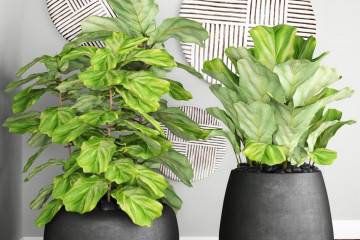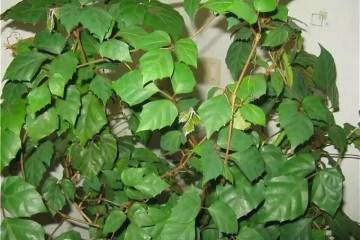Peperomia blunt-leaved - home care
Content:
Peperomia is an evergreen houseplant. It gained its popularity not for its lush flowering, but for the bright leaves of an unusual color. Today, this type of indoor flowers is gaining popularity in Russia, many amateurs are looking for a description and characteristics of the plant, trying to find an interesting variety and grow it in accordance with all the rules of agricultural technology.
What does it look like, which family it belongs to
The genus of plants Peperomia belongs to the Pepper family. The plant has about 900 varieties, radically different from each other. Under natural conditions, the flower grows in the tropical zone of America, less often in Asia, India, South Korea, Japan.
The most popular type is Peperomia Obtusifolia, which is associated with the high decorativeness of the plant.
Each species and variety differ in color, structure, shape and size of leaves. The color of the shoots ranges from cream to bright green. It is the leaves that make peperomia attractive, its peduncles are inexpressive, small and pale.
For home cultivation, about 50 varieties are used, which belong to the following types:
- velvety - height up to 40 cm, purple stems, pointed leaves with light veins, inflorescences up to 7 cm;
- silvery - the height is small, the leaves are silvery-green with dark green stripes, the flowers are yellow or green, up to 5 cm;
- wrinkled - corrugated leaves of green or cherry color, inflorescences of different colors, white, pink, brown;
- pleasant - height up to 30 cm, dense greens, purple stems, bright green leaves, inflorescences up to 1.5 cm;
- spotted - erect or semi-lying shoots, leaves are bright green with green or brown inflorescences;
- klusielistaya - leaves are yellow-green with a pink border up to 15 cm long, inflorescences are pale green.
The smell of crushed peperomia leaves can relieve headaches and fatigue. The juice of the leaves and its volatile substances kill streptococci, staphylococci, sarcins. Such properties are due to the content of special substances - ethers. Actually, this is why the plant belongs to the Pepper family.
Home care features
A pot with a flower is placed on the east or west side. On southern windowsills, tulle or other translucent shading material is required.
Peperomia of the blunt-leaved variety responds well to artificial lighting from fluorescent lamps or phytolamps. The duration of daylight hours should be from 8 hours.
In the warm season, the optimum air temperature is 20-20 ° C, in the cold season - 18-22 ° C, the soil should not cool below 17 ° C.
Home care for blunt-leaved peperomia consists in abundant watering, especially during the growing season. In autumn and winter, watering is reduced. Warm water is used, several degrees higher than the air temperature.
Shoots react painfully to dry air. At normal humidity, additional spraying is not carried out. To humidify the air, it is enough to put a vessel with water on the windowsill. At the same time, the round-leaved and gray-haired peperomia do not tolerate the moisturizing of the shoots.
Top dressing is applied only in spring and summer: complex fertilizer is applied to the soil 2 times a month.
Pruning is carried out on those varieties that have heavy branches, and which, reaching a length of 18-20 cm, begin to sag and break off. In spring and summer, crown-forming pruning is carried out, and at the end of autumn, sanitary pruning, ridding the flower of dry and diseased branches.
The young plant is transplanted annually, as the root system grows. After 3 years, the number of transplants is reduced to 1 time in 2 years. Fertile and loose soil is selected, drainage is laid on the bottom.
When and how it blooms
Most often, flowering occurs once a year, but some species bloom every season. With annual flowering, the buds are formed in late spring - early summer, the inflorescences are inconspicuous and odorless.
It is recommended to remove the inflorescences even at the stage of their formation, so that the shoots will get more nutrients. The flowers are in the form of tails or spikelets, their length ranges from 1.5 to 12 cm, color from light green to dark brown. Some varieties have cream or white flowers, comb-shaped in shape. The formation of flowers occurs under the condition of daylight hours at least 12 hours.
How blunt-leaved peperomia reproduces
Peperomia can be easily propagated by any vegetative method. An exception is sowing seeds, which is not given to every experienced florist.
- Reproduction of blunt-leaved peperomia by seeds.
Ripe seeds from the fruit are dried and folded in a paper bag and stored in a cool place.
In March-April, seeds are placed in a container filled with wet sand or universal soil. Sprinkle on top of soil 1.5 mm thick, spray and cover with glass or film. Once a week, the film is removed for airing.
A lot of sunlight should fall on the planting, the optimum air temperature for growing is 24-27 ° C. When 1-2 true leaves appear on the sprout, they are dived into separate containers with soil from universal earth, fertile turf, sand and peat.
- Propagation by stem cuttings.
Intermediate and apical cuttings with air nodes are used (each of them should have at least 2).
They are rooted in wet sand, a mixture of sand and peat, and clean water. The air temperature for successful reproduction should be 24-25 ° С. The material is lowered into the substrate for a week, after the roots appear, the sprout is transplanted into a separate container with fertile soil.
For the first two weeks, it is better to put the pot in the shade, after which to provide the usual conditions for peperomia. When planting a plant, nitrogenous fertilizer is applied to the soil.
- Reproduction by a sheet.
The next day, the leaf is half dug into the moist soil, the container is placed in the shade. The stem will appear only after six months.
- Reproduction by division.
The procedure is performed during the annual transplant.
The roots of peperomia are not very sensitive, so they can be safely separated. The resulting two parts of the plant can be planted in different pots with a drainage layer and universal soil. For the first week, the shoots should not be exposed to direct sunlight.
Possible growing problems
Dull-leaved peperomia has average immunity. If you take care of a flower incorrectly, parasites can appear on it. At the first signs of illness, a soap solution can help; in case of a serious lesion, insecticides cannot be avoided.
The most common diseases:
- Root rot. It manifests itself in the form of gray-brown wet spots at the base of the stem, which gradually pass to the leaves. Treatment is effective only at an early stage. The plant is removed from the soil, the affected areas are cut off, the roots are soaked in a light pink solution of potassium permanganate, a solution of liquid vitriol or Bordeaux liquid, sprinkled with activated carbon and planted in clean soil.
- Mealybug. The lower part of the leaf plate is covered with a white bloom. The worm is erased with a cotton pad dipped in soapy water with the addition of alcohol or calendula tincture. In advanced cases, insecticides are used.
- Thrips. Parasites can be detected by thin beige lines on the leaves, the leaf plate becomes pale and sticky. Parasites can be caught on fly sticky tape, larvae are killed by insecticides.
- Nematodes. Leaves are covered with spots, roots are spherical formations. There is no point in saving a completely affected plant, it is thrown away, and the pot in which it grew is treated with boiling water. Single affected leaves and roots are cut off, the plant is treated with insecticides.
- Spider mite. A thin thread appears between the petioles and stems, the leaves dry out. The parasites are removed mechanically, the shoots are treated with a soap-alcohol solution, the larva are killed with chemical acaricides.
Dull-leaved peperomia is a tropical beauty that will not grow on every windowsill. Each variety of this variety may respond differently to standard home care, so adjusting conditions must be experienced.



















